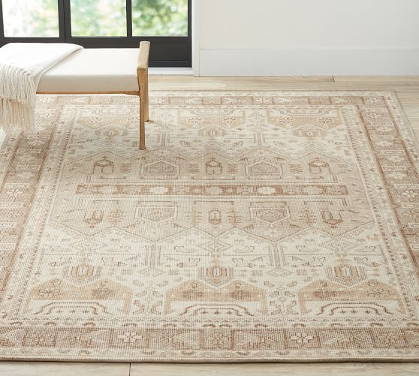The Incredible Differences Between Hand-Knotted Rugs and Machine-Made Ones
Sep 29, 2022 11:37
Hand-Tied Rug

A hand-knotted rug is woven with thousands of tiny knots. The process is extremely labor-intensive and requires a high level of skill. The quality is better when there are more knots per square inch.
Machine-Made Rug
A machine-made rug uses primarily synthetic fibers. The production process involves fully automated machinery. As a result, the cost of making a machine-made rug is extremely low, and it can be produced very quickly. Moreover, a machine-made rug is not knotted.
There are several differences between a hand-tied rug and a machine-made rug. While they are both made using the same technique, machine-made rugs are less expensive and can be created quickly. Hand-tied rugs are often more expensive due to the labor-intensive process involved in weaving. They can also vary in color and texture.
A hand-knotted rug is created using a special loom that is designed for this purpose. The weaver then manually inserts each knot into the foundation of the rug. These hand-knotted rugs are often known for their durability and velvety texture.
Hand-tied rugs are designed to last longer and are a more durable option for areas of high traffic. In contrast, machine-made rugs are not suitable for high traffic areas and cannot stand rough use. Historically, rugs and carpets have evolved from purely domestic uses to artistic forms. Nowadays, hand-made and knotted rugs are deemed to be more valuable, so they are better choices for high-traffic areas.
There is also the need for a getting a proper sized rugs for which ever place they are to be put upon. In case of beds and mattresses, we always get them by checking the mattress & bed size-dimension chart and the same must be done in case of rugs as well.
Hand-Tied Rugs Vs Machine-Made Rugs
Hand-tied rugs are created by hand on a loom, while machine-made rugs are mass-produced on large power looms. Despite their similarities, the two types of rugs are surprisingly different in their quality and price.
● Hand-knotted rugs are made from a wide variety of materials. The most common types of fabric used in loom knotted rugs are wool, cotton, silk, and bamboo viscose.● Hand-knotted rugs are usually more expensive than their machine-made counterparts, due to their finer details and the fact that they require more skilled artisans.● Machine-made rugs are made by weaving large swaths of backing material with several needles. The process results in a rug with a uniform, high pile.● Machine-made rugs are also available at a lower price and are often made from synthetic materials.● Machine-made rugs are cheap and durable, but they don't have the aesthetic value of hand-tied rugs. Also, they're more likely to wear and tear over time.● Machine-made rugs have lower labor costs and can be made quickly.● Hand-tied rugs usually have a higher knot count and can be harder to find than machine-made rugs. They can also be used as outdoor rugs as outdoor rugs easy to clean.
How to Create a Hand-Tied Rug?
Creating a hand-tied rug is a time-honored tradition. The process begins with a warp that is strung vertically on a loom. Many traditional societies still use this technique today. However, machine-made rugs are much faster and do not require human attention.
Latch Hooking
Hand-tied rugs are created using several techniques. The first is latch hooking, which involves pulling loops of yarn through a stiff woven base. This technique uses a hinged hook to pull the strands of yarn from the back to the front, creating a rug. It is more flexible than plainweave, as the weaver has more freedom to make design decisions.
Turkish Knots
Hand-tied rugs are often made from Turkish or Persian knots. These knots are strong and durable, but their shape makes them difficult to pack tightly. This means that they are better suited for thicker rugs and geometric designs.
Bokhara Knots
Hand-tied rugs are woven using a knotted method. This technique is widely used in Iran, Afghanistan, China, and Central Asia. It is also used in Pakistan and India. It creates an extremely fine and precise weave. The number of knots per square inch is also measured. The density of the knots is an indicator of value. The quality is directly proportional to density.
Mercerized Cotton
When creating a hand-tied rug using a mercerized cotton fabric, there are various techniques to choose from. Among these techniques is chain stitching, which involves looping a thread around the warps. This process locks in the final weft at the end of the rug, preventing it from unraveling.
Silk
Silk hand-tied rug techniques start with a design drawn on graph paper and placed on a loom frame. The warps are woven using cotton or wool threads and create the base of the rug. The weaver secures the warps by arranging them in horizontal rows. The weft, made of silk, wool, or a combination of both, is woven horizontally and interconnects with the warp to form the design.
Design Plates
Design plates for hand-tied rugs are guides for the artisan to follow when making the rug. These patterns usually come from cartoons or detailed design plates that show the colours that each knot should use. Tribal and village rugs may also follow this template method, but the appearance will often be more natural and un-polished. Some people prefer the symmetry and perfectionism of design plates, while others appreciate the authenticity of raw designs.
Apart from the designs, you also need to take care of the sizes before purchasing either a handmade or a machine made rugs. For ex - while buying mattresses, we always look for the mattress & bed sizes and dimensions before buying and the same should be followed for the rugs.
Conclusion
Handmade rugs are more durable than their machine-made counterparts. They have more knots and weaves per square inch, which increases their durability. As a result, hand-knotted rugs can last for decades.







































































